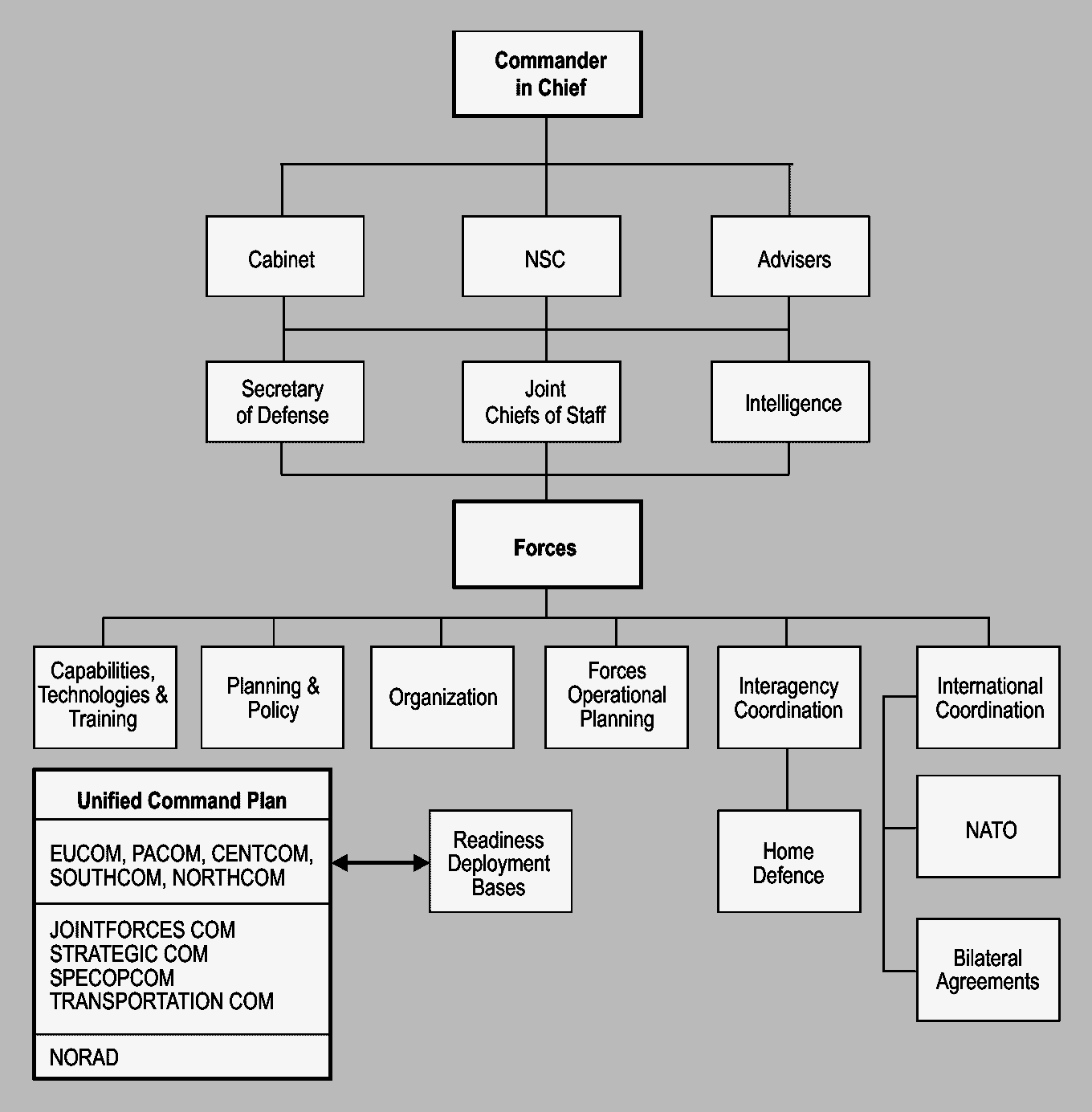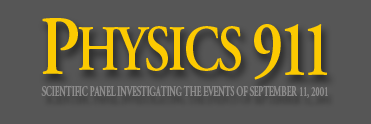The ‘torture fiasco’ at the Abu-Ghraib prison in Iraq called into question some very troubling aspects having to do with something called ‘chain of command’ – when troubling things happen ‘on the ground’ – who is ultimately responsible? By feigning ignorance at each end of the command chain, it is possible to complete more questionable operations without the requirement of taking responsiblity for it. In the case of Abu Ghraib – higher ups ultimately claimed that the prison guards and other officers responsible for maintenance at the facility were ‘acting alone’ and not on the authority of any government officials. However – we also know that the particular tactics employed, though gruesome, have been commonly used in many cultures of incarceration throughout the world, as it leads to ‘positive results’ for the miltary.
 |
|
|
|
 |
|
|
 |
|
Diagram: United States Chain of Command.
At left is the classical chain of command structure. Of course there are policy mechanisms in place at each point – originally meant as failsafes, which function like valves – permitting ‘command traffic’ to travel along more complex paths. The President can also, of course, take ‘recommendations’ from other sources, as the actual power structure dictates.
An example of this might be ‘special projects’ or during ‘Black Ops’, ‘Special Operations’ etc. where the chain of command is modified for specific purposes having to do with ‘security’. Note the cells at lower right – which have particular dominance over the Commander-in-Chief’s authority and planning.
click on image to enlarge if necessary.
|
|
 |
|
|
|
 |
Likewise, ‘Black Ops’ and ‘False Flag’ Operations can also be successfully accomplished by actually blocking the flow of information to subordinates. By merit of not disclosing the aim of particular operations – or making subordinates aware of the goals of a specific suboperation – operations can be carried out that might otherwise be troubling or questionable to lower officers. Often – a valid criticism of such operations is – "the number of people involved in the operation would have been too great – how could everyone involved in something that scale be kept quiet?". The elegant answer to this is ‘Chain of Command’. By keeping lower units aware only of the elements of a required task, there is no peril or risk of disclosure possible.
In direct oppostition to what is termed ‘Mission Style’ Tactics, the US Military (notable but not entirely unique in this regard) exercises a hierarchical logistical framework known as ‘Operational Control’ or previously ‘Command and Control’ – The former, ‘Mission Style’ – exercised by many other armies worldwide provide greater responsibility to subordinate leaders – allowing them to accomplish a mission according to it’s intent, rather than it’s ‘letter’ or specific direction. The Unites States Military chain-of-command is exactly the opposite – and enforces a policy wherein only the most rudimentary of instructions to complete a given task is passed to a subordinate. While this may have benefits to the military as a whole when it comes to a hostage situation (a soldier will seldom have any idea of ‘the big picture’ or why they are ‘there’, etc) – it also creates certain ethical problems – i.e. – that soldiers may carry out orders they might not consent to otherwise, had they an understanding of the larger goal.
|
The (Department of Defense) Dictionary of Military and Associated Terms defines it as:
"(DOD) Command authority that may be exercised by commanders at any echelon at or below the level of combatant command. Operational control is inherent in combatant command (command authority) and may be delegated within the command. Operational control is the authority to perform those functions of command over subordinate forces involving organizing and employing commands and forces, assigning tasks, designating objectives, and giving authoritative direction necessary to accomplish the mission. Operational control includes authoritative direction over all aspects of military operations and joint training necessary to accomplish missions assigned to the command. Operational control should be exercised through the commanders of subordinate organizations. Normally this authority is exercised through subordinate joint force commanders and Service and/or functional component commanders. Operational control normally provides full authority to organize commands and forces and to employ those forces as the commander in operational control considers necessary to accomplish assigned missions; it does not, in and of itself, include authoritative direction for logistics or matters of administration, discipline, internal organization, or unit training. Also called OPCON. "
|
A further deterrent against leakage of ‘diplomatic plans’ or other duplicity is the existence of an entirely separate protocol and command chain for upper level commanders at the Pentagon (for example). This is called ‘COCOM’ or ‘Combatant Command’ –
|
The (Department of Defense) Dictionary of Military and Associated Terms defines COCOM as:
"(DOD) Nontransferable command authority established by Title 10 ("Armed Forces"), United States Code, Section 164, exercised only by commanders of unified or specified combatant commands unless otherwise directed by the President or the Secretary of Defense. Combatant command (command authority) cannot be delegated and is the authority of a combatant commander to perform those functions of command over assigned forces involving organizing and employing commands and forces, assigning tasks, designating objectives, and giving authoritative direction over all aspects of military operations, joint training, and logistics necessary to accomplish the missions assigned to the command. Combatant command (command authority) should be exercised through the commanders of subordinate organizations. Normally this authority is exercised through subordinate joint force commanders and Service and/or functional component commanders. Combatant command (command authority) provides full authority to organize and employ commands and forces as the combatant commander considers necessary to accomplish assigned missions. Operational control is inherent in combatant command (command authority). Also called COCOM. ."
|
WIkipedia Page on ‘Command and Control’
WIkipedia Page on ‘Command Hierarchy’
US Department of Defense Dictionary of Miltary Terms
Global Security’s page on ‘Strategic Hierarchy’
|




 List of Members
Log in
List of Members
Log in